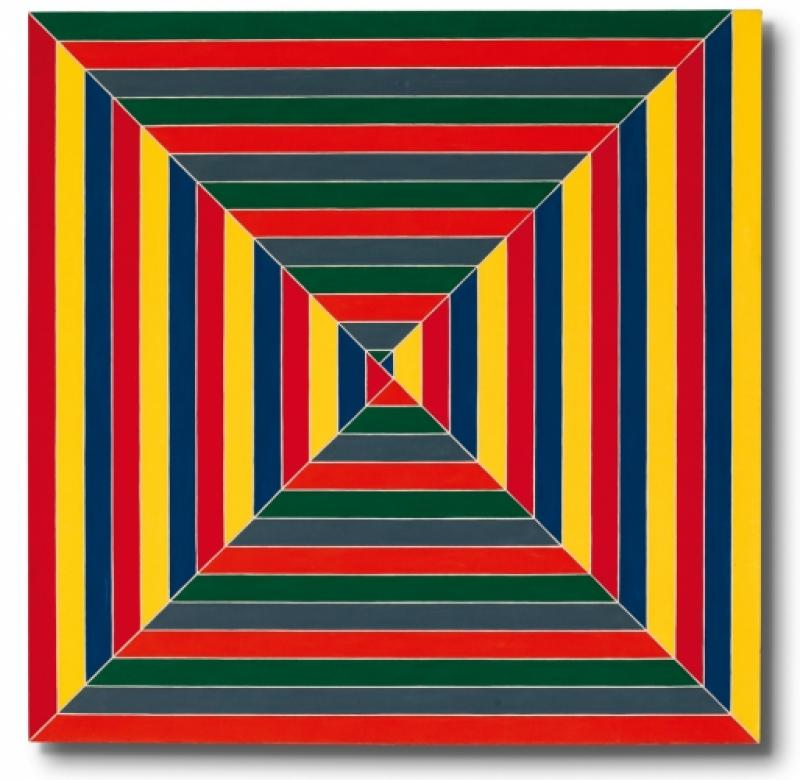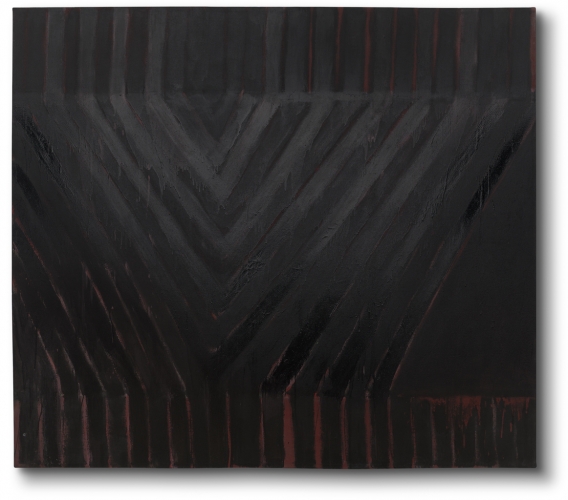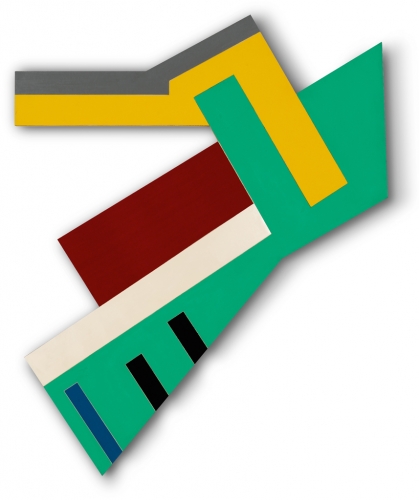Frank Stella: Connections, Haunch of Venison | reviews, news & interviews
Frank Stella: Connections, Haunch of Venison
Frank Stella: Connections, Haunch of Venison
Stella paints beautiful answers to intriguing questions - only where's the heart?

Art about art is one of my favourite kinds of art. Paintings, drawings, sculptures, films - works of art which talk about what art is, what the image is, what art can represent and what it can't - all appeal. It is not just a picture of some prostitutes and some African masks - it is Les demoiselles d'Avignon by Picasso and it blows apart the boundaries of painting by cramming three dimensions into two.
I know that Stella is someone contemporary art critics should love - he methodically and beautifully asks those key questions about art, he is (by his own assessment, not much demurred from) one of the greatest abstract painters of his generation. There is nothing wrong with this retrospective by any means: two rooms are taken up almost solely by the sketches, designs, maquettes and realisations of two works of art, a detailed and enlightening curation showing the thought process and method of manufacture, and how the idea develops. And yet, and yet...
 The first painting is in many ways the most stimulating: Delta (1958) (pictured left) is a series of chevrons whose ends extend up or down, all painted in black. Inspired by Jasper Johns's stripy works, Stella decided to work in the same way, except in anger he turned to black. Suddenly an exploration of colour fields turned into an investigation of depth. The chevrons alternate between glistening, sweating blacks which ask the viewer whether it is possible to distinguish different planes, foreground from background - the form of a traditional picture. (By this point in Abstract Expressionism, representation of an object is no longer an issue, Rothko, Newman et al having done away with that.) This is the question he would go on to answer, in varying ways, ever since.
The first painting is in many ways the most stimulating: Delta (1958) (pictured left) is a series of chevrons whose ends extend up or down, all painted in black. Inspired by Jasper Johns's stripy works, Stella decided to work in the same way, except in anger he turned to black. Suddenly an exploration of colour fields turned into an investigation of depth. The chevrons alternate between glistening, sweating blacks which ask the viewer whether it is possible to distinguish different planes, foreground from background - the form of a traditional picture. (By this point in Abstract Expressionism, representation of an object is no longer an issue, Rothko, Newman et al having done away with that.) This is the question he would go on to answer, in varying ways, ever since.
One of his responses was that instead of some false illusionistic manner of creating depth - painting the far-off man smaller - you had to give the canvas actual depth, make some layers sit further forward, some backward. Felstzyn III (1971) is on an adjacent wall, with its further-back green plane.
 This line of argument is shown most eloquently in the next room, with three versions of Suchowola (1973) (pictured right), where we start with a flat, if highly irregular, shape (his Irregular Polygons play the same game with the form of the picture), then have the same shape but with colours sitting on different levels, and finally Stella tilts some of the planes forward, so they sit at angles to others. This is a revelation, putting three dimensions into actual painting (as opposed to Cubism's painted third dimension or Rauschenberg's real objects on canvases). This show does not hide Stella's struggle with space, and the results are thrilling to the eye and the mind: odd colours, odd shapes, odd angles striving to break out of art as we knew it.
This line of argument is shown most eloquently in the next room, with three versions of Suchowola (1973) (pictured right), where we start with a flat, if highly irregular, shape (his Irregular Polygons play the same game with the form of the picture), then have the same shape but with colours sitting on different levels, and finally Stella tilts some of the planes forward, so they sit at angles to others. This is a revelation, putting three dimensions into actual painting (as opposed to Cubism's painted third dimension or Rauschenberg's real objects on canvases). This show does not hide Stella's struggle with space, and the results are thrilling to the eye and the mind: odd colours, odd shapes, odd angles striving to break out of art as we knew it.
A complete dive into three dimensions is in the next room, where La penna di hu (1983-87) takes shape. Stella uses cones, tubes, even something which looks like a Soviet sickle to make a sculpture, no longer a painting. It is dynamic and witty and prettily coloured in all its variations. These pieces might seem like nothing new - sculptors have been working in 3D forever - but because they developed from his work in painting, they reflect a new approach to sculpture. There are still paintings and drawings of La penna di hu which have almost a perverse desire to show that, having captured painting in sculpture, sculpture can be captured in painting. (His later move into stand-alone sculpture followed naturally.)
The questions Stella is asking are academic, of great moment to artists but probably not to others
All of these pieces made my mind hum. Stella's most famous paintings, the bright stripes and squares (such as Les Indes galantes above), did not. I looked at all the examples Haunch offered and not one stirred me - where had Stella's ability to ask fascinating questions gone? The endless combinations of schoolkid colours are repetitive - hypnotic and appealing to the eye, perhaps, but deeply repetitive. Instead of wondering how he can squash reality onto a canvas, he seems to be dancing about like a maiden round a maypole.
While I was being disabused by these works, a thundering realisation struck me. Where was the human in all of this? And, looking back to the start, where was the human in any of this? The questions Stella is asking are academic, of great moment to artists but probably not to others. I am as interested in shapes and planes as the next man, but these are cool works, not stimulated or impassioned. What, ultimately, do these works mean to us? This is not a plea for sentiment in art, but some of the greatest art about art - such as the Demoiselles - still manages to be cheeky, or erotic, or desperate, or loving, or grievous, or pitiable, or monstrous, or in some manner moving. Stella, I'm sorry to say, is not.
- Frank Stella: Connections at Haunch of Venison until 19 November
Explore topics
Share this article
The future of Arts Journalism
You can stop theartsdesk.com closing!
We urgently need financing to survive. Our fundraising drive has thus far raised £49,000 but we need to reach £100,000 or we will be forced to close. Please contribute here: https://gofund.me/c3f6033d
And if you can forward this information to anyone who might assist, we’d be grateful.

Subscribe to theartsdesk.com
Thank you for continuing to read our work on theartsdesk.com. For unlimited access to every article in its entirety, including our archive of more than 15,000 pieces, we're asking for £5 per month or £40 per year. We feel it's a very good deal, and hope you do too.
To take a subscription now simply click here.
And if you're looking for that extra gift for a friend or family member, why not treat them to a theartsdesk.com gift subscription?
more Visual arts
 'We are bowled over!' Thank you for your messages of love and support
Much-appreciated words of commendation from readers and the cultural community
'We are bowled over!' Thank you for your messages of love and support
Much-appreciated words of commendation from readers and the cultural community
 Folkestone Triennial 2025 - landscape, seascape, art lovers' escape
Locally rooted festival brings home many but not all global concerns
Folkestone Triennial 2025 - landscape, seascape, art lovers' escape
Locally rooted festival brings home many but not all global concerns
 Sir Brian Clarke (1953-2025) - a personal tribute
Remembering an artist with a gift for the transcendent
Sir Brian Clarke (1953-2025) - a personal tribute
Remembering an artist with a gift for the transcendent
 Emily Kam Kngwarray, Tate Modern review - glimpses of another world
Pictures that are an affirmation of belonging
Emily Kam Kngwarray, Tate Modern review - glimpses of another world
Pictures that are an affirmation of belonging
 Kiefer / Van Gogh, Royal Academy review - a pairing of opposites
Small scale intensity meets large scale melodrama
Kiefer / Van Gogh, Royal Academy review - a pairing of opposites
Small scale intensity meets large scale melodrama
 Jenny Saville: The Anatomy of Painting, National Portrait Gallery review - a protégé losing her way
A brilliant painter in search of a worthwhile subject
Jenny Saville: The Anatomy of Painting, National Portrait Gallery review - a protégé losing her way
A brilliant painter in search of a worthwhile subject
 Abstract Erotic, Courtauld Gallery review - sculpture that is sensuous, funny and subversive
Testing the boundaries of good taste, and winning
Abstract Erotic, Courtauld Gallery review - sculpture that is sensuous, funny and subversive
Testing the boundaries of good taste, and winning
 Edward Burra, Tate Britain review - watercolour made mainstream
Social satire with a nasty bite
Edward Burra, Tate Britain review - watercolour made mainstream
Social satire with a nasty bite
 Ithell Colquhoun, Tate Britain review - revelations of a weird and wonderful world
Emanations from the unconscious
Ithell Colquhoun, Tate Britain review - revelations of a weird and wonderful world
Emanations from the unconscious
 Rachel Jones: Gated Canyons, Dulwich Picture Gallery review - teeth with a real bite
Mouths have never looked so good
Rachel Jones: Gated Canyons, Dulwich Picture Gallery review - teeth with a real bite
Mouths have never looked so good
 Yoshitomo Nara, Hayward Gallery review - sickeningly cute kids
How to make millions out of kitsch
Yoshitomo Nara, Hayward Gallery review - sickeningly cute kids
How to make millions out of kitsch
 Hamad Butt: Apprehensions, Whitechapel Gallery review - cool, calm and potentially lethal
The YBA who didn’t have time to become a household name
Hamad Butt: Apprehensions, Whitechapel Gallery review - cool, calm and potentially lethal
The YBA who didn’t have time to become a household name

Add comment